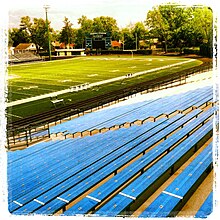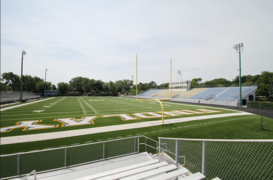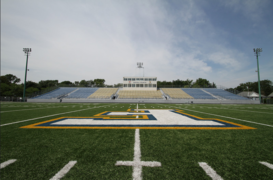
AstroTurf is an American subsidiary of SportGroup that produces artificial turf for playing surfaces in sports. The original AstroTurf product was a short-pile synthetic turf invented in 1965 by Monsanto. Since the early 2000s, AstroTurf has marketed taller pile systems that use infill materials to better replicate natural turf. In 2016, AstroTurf became a subsidiary of German-based SportGroup, a family of sports surfacing companies, which itself is owned by the investment firm Equistone Partners Europe.

Camp Randall Stadium is an outdoor stadium in Madison, Wisconsin, located on the campus of the University of Wisconsin. It has been the home of the Wisconsin Badgers football team in rudimentary form since 1895, and as a fully functioning stadium since 1917. It is the oldest and fifth largest stadium in the Big Ten Conference. The field has a conventional north–south alignment, at an approximate elevation of 880 feet (270 m) above sea level.
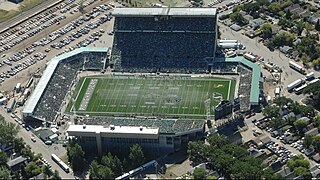
Taylor Field, known in its latter years as Mosaic Stadium at Taylor Field for sponsorship reasons, was an open-air stadium located in Regina, Saskatchewan. It was the home field of the Canadian Football League's Saskatchewan Roughriders from 1936 until 2016, although a playing field existed at the site as early as 1910 and the team began playing there as early as 1921. Originally designed primarily to house baseball the stadium was converted to a football-only facility in 1966.

Paycor Stadium, previously known as Paul Brown Stadium, is an outdoor football stadium in Cincinnati, Ohio. It is the home venue of the Cincinnati Bengals of the National Football League (NFL) and opened on August 19, 2000.

CEFCU ('sef-kyü) Stadium, formerly known as Spartan Stadium, is an outdoor athletic stadium on the west coast of the United States, located in the Spartan Keyes neighborhood of central San Jose, California. Owned by San José State University, the venue is the longtime home of Spartan football; it also hosts the university's commencement ceremony on Memorial Day weekend, and occasional high school football games. Known as Spartan Stadium for over eight decades, it was renamed in 2016.

Ohio Stadium is an American football stadium in Columbus, Ohio, on the campus of Ohio State University. It primarily serves as the home venue of the Ohio State Buckeyes football team and is also the site for the university's Spring Commencement ceremonies each May. Common nicknames for the stadium include "The Horseshoe", "The Shoe", and "The House That Harley Built".

FieldTurf is a brand of artificial turf playing surface. It is manufactured and installed by FieldTurf Tarkett, a division of French company Tarkett. FieldTurf is headquartered in Montreal, Quebec, Canada, and its primary manufacturing facility is located in Calhoun, Georgia, United States. With a design intended to more accurately replicate real grass, the new product rapidly gained popularity in the late 1990s.

Mountaineer Field at Milan Puskar Stadium is an American football stadium in Morgantown, West Virginia, on the campus of West Virginia University. It opened in 1980 and serves as the home field for the West Virginia Mountaineers football team. On the day the stadium opened, at an opening ceremony, John Denver touched down on the field in a helicopter, performed the song "Take Me Home, Country Roads," and then immediately departed by helicopter. The facility is named for Milan Puskar, a Morgantown resident and founder of Mylan Pharmaceuticals, Inc. who donated $20 million to the university in 2004. The playing surface retains the stadium's original name of Mountaineer Field, which was also the name of WVU's previous football stadium. The stadium’s design was inspired by Jack Trice Stadium, which opened a few years earlier at Iowa State University.

Artificial turf is a surface of synthetic fibers made to look like natural grass, used in sports arenas, residential lawns and commercial applications that traditionally use grass. It is much more durable than grass and easily maintained without irrigation or trimming, although periodic cleaning is required. Stadiums that are substantially covered and/or at high latitudes often use artificial turf, as they typically lack enough sunlight for photosynthesis and substitutes for solar radiation are prohibitively expensive and energy-intensive. Disadvantages include increased risk of injury especially when used in athletic competition, as well as health and environmental concerns about the petroleum and toxic chemicals used in its manufacture.

War Memorial Stadium, also known as Jonah Field at War Memorial Stadium, is an outdoor college football stadium in the western United States, located on the campus of the University of Wyoming in Laramie.

Faurot Field at Memorial Stadium is an outdoor sports stadium in Columbia, Missouri, United States, on the campus of the University of Missouri. It is primarily used for football and serves as the home field for the Missouri Tigers' program. It is the third-largest sports facility by seating capacity in the state of Missouri, behind The Dome at America's Center in St. Louis and Arrowhead Stadium in Kansas City. In 1972, Memorial Stadium's playing surface was named Faurot Field in honor of longtime coach Don Faurot.

Crumb rubber is recycled rubber produced from automotive and truck scrap tires. During the recycling process, steel and tire cord (fluff) are removed, leaving tire rubber with a granular consistency. Continued processing with a granulator or cracker mill, possibly with the aid of cryogenics or by mechanical means, reduces the size of the particles further. The particles are sized and classified based on various criteria including color. The granulate is sized by passing through a screen, the size based on a dimension or mesh. Crumb rubber is often used in artificial turf as cushioning.

Allen E. Paulson Stadium at Evans Family Field is a 25,000-seat on-campus football stadium in Statesboro, Georgia. It is home to the Georgia Southern Eagles football team and the focal point of Erk Russell Athletic Park.

Homer Bryce Stadium, located in Nacogdoches, Texas, is the home of Stephen F. Austin State University's Lumberjack football and Ladyjack and Lumberjack track and field events. The stadium includes a walking and running track open to the public. After renovations to take place over the summer of 2021 the track will be closed to the public. Recent renovations to the area include a sports medicine and academic center addition to the field house that houses the new athletic training program and the installation of a new artificial turf surface provided by a donation from a former Lumberjack football letterman. A state of the art video board with replay screen was completed in September 2016, home to largest video board in the South land Conference.
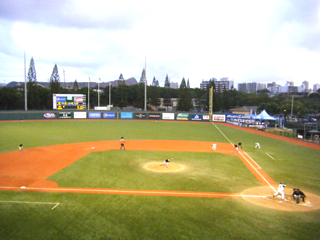
Les Murakami Stadium is the baseball stadium at the University of Hawaii at Manoa in Honolulu CDP, City and County of Honolulu, Hawaii, United States. The stadium was built in 1984 and renamed after legendary Rainbow coach Les Murakami for the 2002 season.

Selby Stadium is a multi-purpose stadium located at Ohio Wesleyan University in Delaware, Ohio. The venue serves as home to the Battling Bishops football, men's and women's lacrosse, women's field hockey, and track & field teams.

Shotwell Stadium is a stadium in Abilene, Texas. It was built in 1959, using Rice Stadium as a model. It was initially named the Public Schools Stadium. The first game played in the stadium was in the fall of 1959. Shortly after the first season, the stadium was renamed Shotwell Stadium, after P. E. Shotwell, a longtime football coach at Abilene High School.
The 15,000-capacity Dick Bivins Stadium is a stadium in Amarillo, Texas, USA, located at 800 S Marrs Street on the city's east side. It is primarily used for American football, and is the home field of the Amarillo Independent School District (AISD). During the season, many Texas Panhandle area high school football teams play regular and post-season games here. These schools include the four AISD-affiliated high schools: Amarillo High, Caprock High, Tascosa High, and Palo Duro High.
Beaver Field at Jim and Bettie Smith Stadium is a baseball stadium in Boone, North Carolina, that is home to the Appalachian State baseball program. Prior to using Beaver Field, the Mountaineers used Lackey Field. The stadium was dedicated on April 10, 2007, with the Mountaineers claiming a 6–1 victory over Gardner-Webb. Appalachian selected AstroTurf as the playing surface for the new stadium, joining a select group of NCAA Division I and MLB programs to use the mix of silica sand and cryogenic rubber to emulate natural grass. The stadium has been mentioned in national publications for its beauty, especially during the fall season.
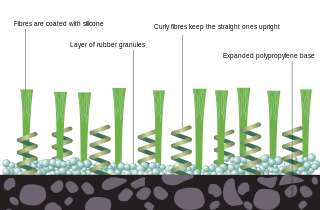
Artificial turf is surface of synthetic fibers resembling natural grass. It is widely used for sports fields for being more hard-wearing and resistant than natural surfaces. Most use infills of crumb rubber from recycled tires; this use is controversial because of concerns that the tires contain carcinogens, though research into the issue is ongoing.
